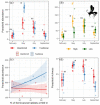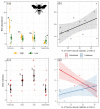Effects of Traditional Orchard Abandonment and Landscape Context on the Beneficial Arthropod Community in a Mediterranean Agroecosystem
- PMID: 36975963
- PMCID: PMC10056667
- DOI: 10.3390/insects14030277
Effects of Traditional Orchard Abandonment and Landscape Context on the Beneficial Arthropod Community in a Mediterranean Agroecosystem
Abstract
Agricultural abandonment is one of the main land-use changes in Europe, and its consequences on biodiversity are context- and taxa-dependent. While several studies have worked on this topic, few have focused on traditional orchards, especially in different landscapes and under a Mediterranean climate. In this context, we aimed to determine the effects of almond orchard abandonment on the communities of three groups of beneficial arthropods and the role of the landscape context in modulating these effects. Between February and September 2019, four samplings were carried out in twelve almond orchards (three abandoned and three traditional (active orchards under traditional agricultural management) located in simple landscapes as well as three abandoned and three traditional in complex landscapes). Abandoned and traditional almond orchards harbor different arthropod communities and diversity metrics that are strongly conditioned by seasonality. Abandoned orchards can favor pollinators and natural enemies, providing alternative resources in simple landscapes. However, the role that abandoned orchards play in simple landscapes disappears as the percentage of semi-natural habitats in the landscape increases. Our results show that landscape simplification, through the loss of semi-natural habitats, has negative consequences on arthropod biodiversity, even in traditional farming landscapes with small fields and high crop diversity.
Keywords: abandonment; bee; landscape complexity; parasitoid; spider; traditional almond orchard.
Conflict of interest statement
The authors declare no conflict of interest. The funders had no role in the design of the study; in the collection, analyses, or interpretation of data; in the writing of the manuscript; or in the decision to publish the results.
Figures






References
-
- IPBES Summary for Policymakers of the Global Assessment Report on Biodiversity and Ecosystem Services of the Intergovernmental Science-Policy Platform on Biodiversity and Ecosystem Services. IPBES. 2019;44:22–47.
-
- Sánchez-Bayo F., Wyckhuys K.A.G. Worldwide Decline of the Entomofauna: A Review of Its Drivers. Biol. Conserv. 2019;232:8–27. doi: 10.1016/j.biocon.2019.01.020. - DOI
-
- Bengtsson J., Ahnström J., Weibull A.C. The Effects of Organic Agriculture on Biodiversity and Abundance: A Meta-Analysis. J. Appl. Ecol. 2005;42:261–269. doi: 10.1111/j.1365-2664.2005.01005.x. - DOI
Grants and funding
LinkOut - more resources
Full Text Sources

